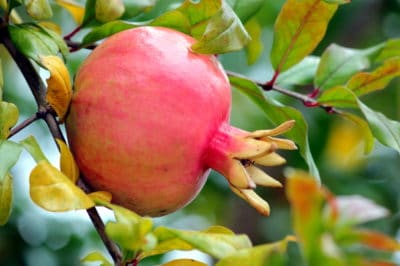USDA Hardiness Zones
Pomegranate trees (Punica granatum) thrive in areas with long, hot and relatively dry summers and cool winters. In the U.S. that usually translates to USDA plant hardiness zones 8 through 11, depending on cultivar. Most U.S. commercially grown pomegranates come from parts of California, Texas and Arizona.
Living in a colder area won’t disqualify you from growing pomegranates, as long as you stick to a super-hardy cultivar such as ‘Russian Red’ or ‘Russia 26.’ They grow in USDA zone 6 and tolerate winter lows of 8°F and 3°F (-13.3°C and -15.5°C), respectively. Even they, however, should be planted in a wind-sheltered spot.
Growing Pomegranates in Colder Zones
If you’re in USDA zone 5 or lower and have your heart set on growing pomegranates, don’t despair. The dwarf variety ‘Nana’ will grow in a container and overwinter indoors. It’s 2 to 4 feet tall, with coral-red summer flowers and edible, 2-inch orange fruits.
Pomegranates and Frost
Frost damages pomegranates in varying degrees, depending on where they grow:
- Most pomegranate varieties grown in India, the Mediterranean countries and the U.S. experience frost damage between 8° and 15°F (-13.3°C and -9.4°).
- Frost occurring after new growth emerges in late spring damages all pomegranate trees, regardless of their location.
- Early, hard freezes happening before fall leaf drop may damage their wood.
Pomegranates, Heat and Humidity
Pomegranates flourish in desert environments, including Saudi Arabia where the thermometer regularly tops 120°F (48.9°C). In the U.S., they’re most productive with a growing season that includes at least 120 days of temperatures above 85°F (29.4°C). As you’d expect, their need for water increases with the heat.
In areas with humid springs, pomegranate flowers often fail to set fruit. Late summer humidity may cause the ripening fruit to split.
Depending on which problem you have, plant a humidity-tolerant cultivar such as ‘Russian Red’ or a low-split variety like ‘Francis.’
Expert gardener’s tip: If you plan to grow pomegranates just for their juice, splitting won’t matter. Simply wash the fruit well before juicing.
Pomegranate Planting Site
From sand to heavy clay, pomegranates handle almost any soil. But like most fruit trees, they grow best in organically rich, deep loam with good drainage and a pH between 5.5 and 7.2.
They’ll tolerate some salt and brief periods of standing water. Where the soil or water contains lots of salt or the annual rainfall exceeds 32 inches, however, they benefit from additional drainage. To provide it, plant them in raised beds 6 inches to 1 foot high and 4 or more feet across.
Sun and Spacing
Pomegranates need six or more hours of daily sun to fruit their best. If you’re planting more than one, position them on an east-west line so the sun will hit them all day. While full sun and high heat may sunburn a few fruits on one side, it won’t hurt their quality at all.
Space pomegranate trees in nitrogen-rich soil 12 to 14 feet apart in their beds, and allow 14 to 17 feet between beds. If they’re in low-nitrogen sand, increase the spacing by half.
Know Before You Grow
All pomegranate fruit grow comes from self-pollinated flowers. While one tree is all you need for a harvest, cross-pollinated trees bear up to 30 percent more fruit. If you have the room, planting two or more trees is the way to go.
Two pomegranates of the same variety will cross pollinate, but commercial growers recommend planting different cultivars. ‘Wonderful’ and ‘Russian Red’ make a successful combination.
Boosting Your Pollination Odds
Whether growing singly or in groups, pomegranates rely on insects and hummingbirds for pollination. To attract them, plant some zinnias, bee balm or perennial salvia nearby.
Or take matters into your own hands and move pollen from flower to flower by hand. Simply transfer it with a soft-bristle artist’s brush or cotton swab. For the best results, do your pollinating early in the morning while the pollen is still fresh and sticky.
